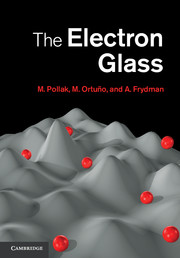Book contents
- Frontmatter
- Contents
- Acknowledgments
- List of symbols
- 1 Introduction
- 2 Disordered electronic systems
- 3 Basics of glasses
- 4 Equilibrium properties of the electron glass
- 5 dc Conductivity
- 6 Other transport properties of electron glasses
- 7 Glassy behavior
- 8 Relationship to other glasses
- 9 Open issues
- References
- Index
1 - Introduction
Published online by Cambridge University Press: 05 January 2013
- Frontmatter
- Contents
- Acknowledgments
- List of symbols
- 1 Introduction
- 2 Disordered electronic systems
- 3 Basics of glasses
- 4 Equilibrium properties of the electron glass
- 5 dc Conductivity
- 6 Other transport properties of electron glasses
- 7 Glassy behavior
- 8 Relationship to other glasses
- 9 Open issues
- References
- Index
Summary
The evolution of the field of electron glasses has a long glassy history of over half a century. As in experiments on glasses where it is hard to determine the beginning of slow relaxation, so it is also difficult to pinpoint the beginning of the field. Perhaps one should assign the beginning to the first experiments on impurity conduction on SiC by Busch and Labhart in 1946. Experiments on impurity conduction were greatly extended by Fan and Fritzcsche and later by Fritzsche and collaborators at Purdue and Chicago, by Zabrodskii and collaborators in Leningrad, and by Davis in Cambridge in the 1950s. Those experiments dealt with doped germanium and silicon. The surprising result of the experiments was a transition from an Arrhenius behavior due to thermal excitation of carriers into the conduction band to a much smaller activation energy as the temperature was lowered. The effect remained unexplained until Mott (1956) and Conwell (1956) independently attributed the lower activation energy to transitions between impurity states, a process that became known as “hopping.” A more quantitative transport theory based on these explanations is due to Miller and Abrahams (1960). These authors also showed that the problem of hopping conduction can be mapped on a random network of resistors, each resistor connecting a pair of impurities with a resistance in accordance with the hopping rate between them.
A parallel very important development came in 1958 with Anderson's paper “Absence of diffusion in certain random lattices,” which studied systems of spins where the disorder prevents spins from diffusing over long distances, a phenomenon that soon after became known as Anderson localization.
- Type
- Chapter
- Information
- The Electron Glass , pp. 1 - 6Publisher: Cambridge University PressPrint publication year: 2012
- 1
- Cited by

